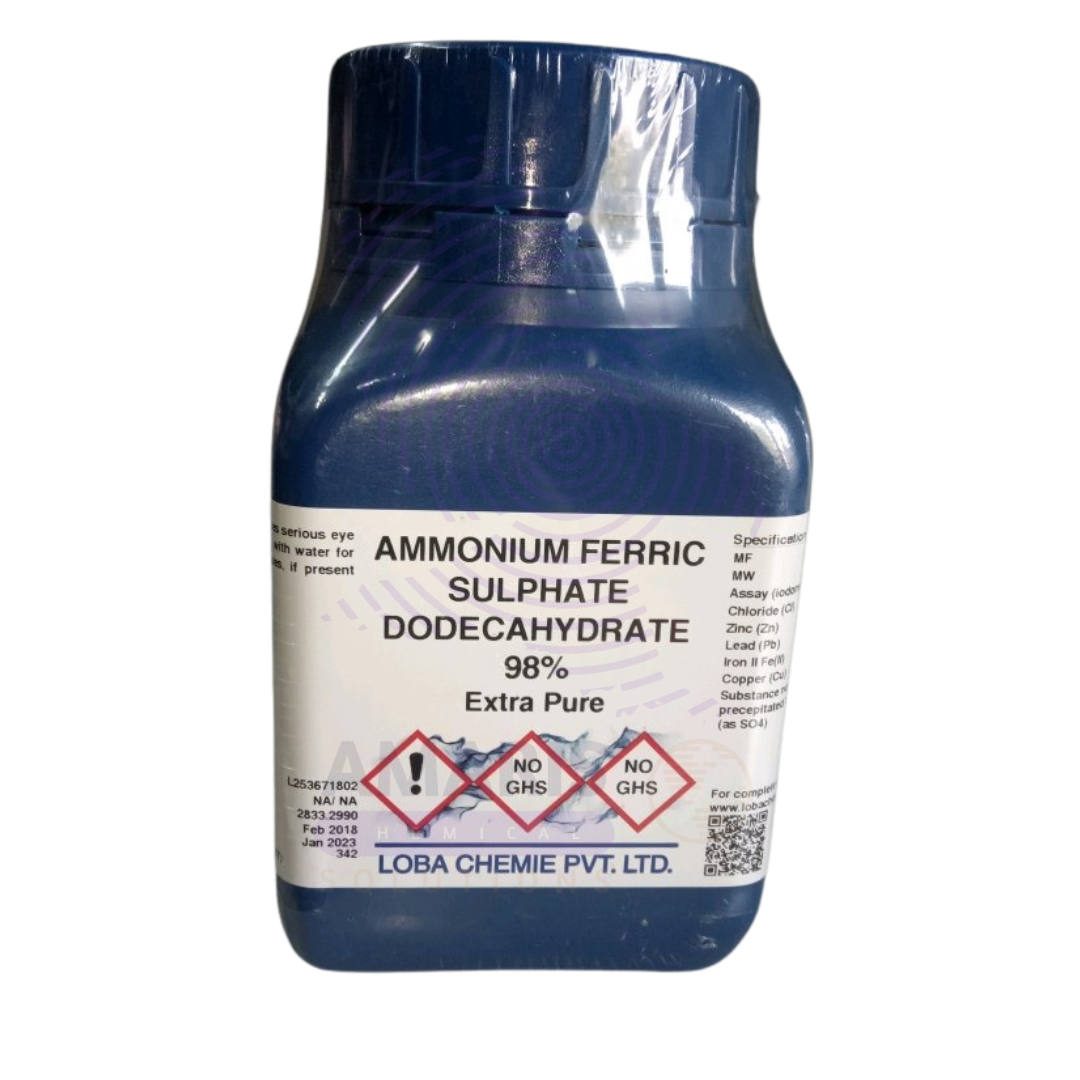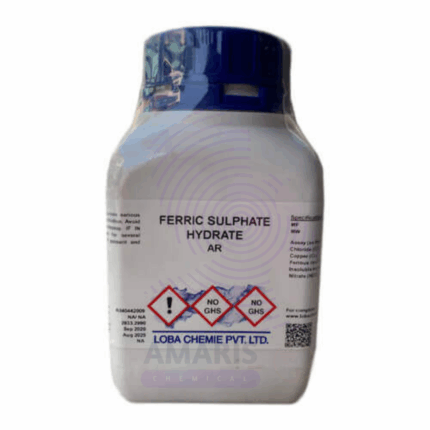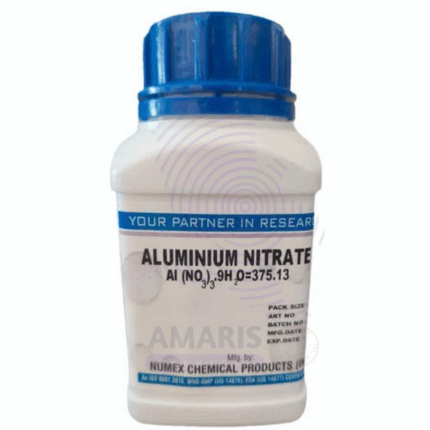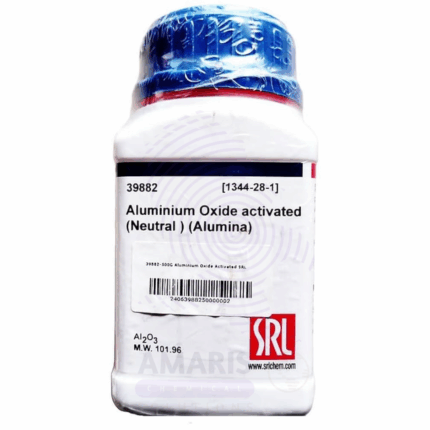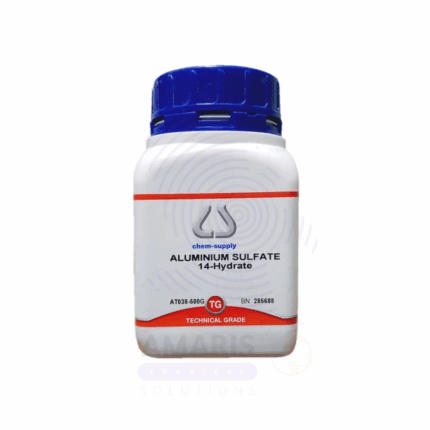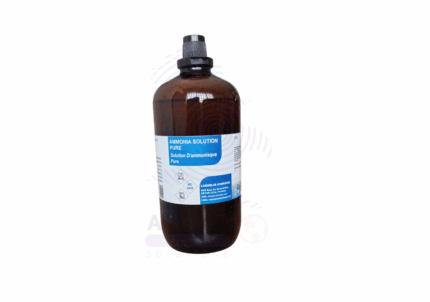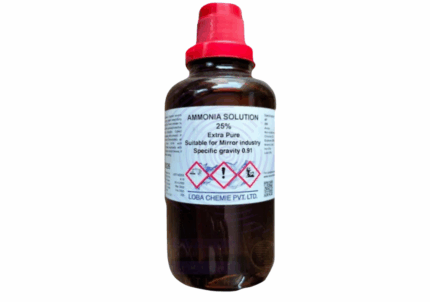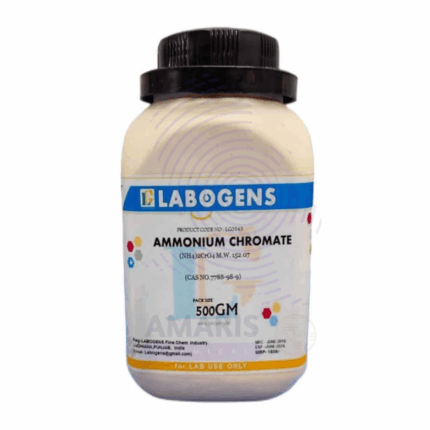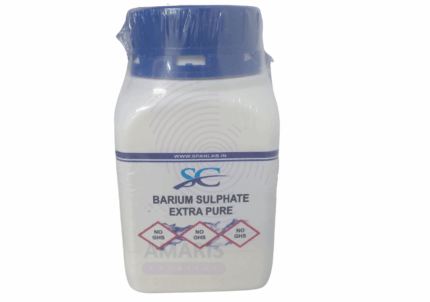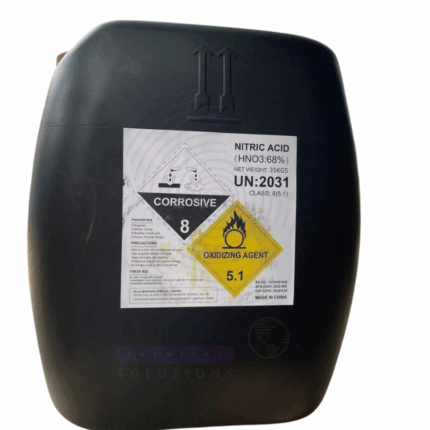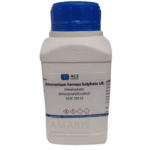
Ammonium Ferric Sulphate Extra Pure
$ 18.00 Original price was: $ 18.00.$ 17.45Current price is: $ 17.45.
Ammonium Ferric Sulphate Extra Pure, also known as ferric ammonium sulfate or iron alum, is a high-purity, violet to light purple crystalline compound used extensively in laboratory settings for analytical and inorganic chemistry. It serves as a reliable oxidizing agent and a standard in redox titrations, particularly in permanganometry. Its stable and non-hygroscopic nature makes it ideal for preparing standard iron solutions, studying coordination complexes, and teaching laboratory procedures involving iron(III) salts. The extra pure grade ensures minimal interference from impurities, enabling accurate and reproducible results in sensitive experiments. It should be stored in a dry, cool environment in well-sealed containers to preserve its chemical integrity.
Ammonium Ferric Sulphate Extra Pure
Primary Uses
- Analytical Reagent in Redox Titrations
- Commonly used as a primary standard oxidizing agent in permanganate titrations due to its stable Fe³⁺ content.
- Source of Fe³⁺ Ions in Inorganic Chemistry
- Provides ferric ions for precipitation reactions, coordination complex formation, or qualitative cation testing.
- Educational Demonstrations in Oxidation States
- Useful in showing iron’s multiple oxidation states and transitions in redox reactions.
- Precursor in Laboratory Synthesis of Iron Compounds
- Used to prepare iron oxides, hydroxides, or mixed salts in controlled synthesis procedures.
- Buffering and Ionic Strength Control in Solution Chemistry
- Sulfate and ammonium content make it suitable for adjusting solution properties in ionic strength experiments.
Secondary Uses
- Crystallization and Crystal Growth Studies
- Forms large, well-defined purple crystals—commonly used in educational labs to demonstrate crystallization techniques.
- Reagent in Photographic and Printing Chemistry (Historical/Research Use)
- Investigated in processes like cyanotype printing and iron-based photographic techniques.
- Environmental Chemistry Simulations
- Models the behavior of Fe³⁺ and sulfate ions in soil or aquatic systems in lab-scale remediation studies.
- Corrosion and Electrochemical Testing
- Used in studies of iron corrosion and electrochemical potential shifts under various pH and ionic conditions.
- Indicator of Complexation Reactions
- Its Fe³⁺ center is sensitive to ligand exchange, making it suitable for use in complexometric titration demonstrations.
| PACK SIZE |
500 grams Plastic Tin |
|---|
1. Basic Identification Attributes
- Chemical Name: Ammonium Ferric Sulphate
- CAS Number: 10138-04-2
- HS Code: 28332990 (Other sulphates of iron)
- Molecular Formula: NH₄Fe(SO₄)₂·12H₂O (Dodecahydrate)
- Synonyms:
- Ferric ammonium sulfate
- Iron alum
- Ammonium iron(III) sulfate dodecahydrate
- Iron(III) ammonium sulfate
- Ammonium alum (iron-type)
2. Physical & Chemical Properties
- Physical State: Solid (crystalline)
- Color & Odor: Violet to pale purple crystals; odorless
- Boiling Point: Decomposes before boiling
- Melting Point: ~39°C (loss of water of crystallization)
- Density/Specific Gravity: ~1.71 g/cm³
- Solubility:
- Water: Soluble (~20 g/100 mL at 20°C)
- Alcohol: Insoluble
- pH Level: ~2.0–3.0 (in 5% aqueous solution)
- Vapor Pressure: Negligible
- Flash Point: Not flammable
- Autoignition Temperature: Not applicable
- Viscosity: Not applicable (solid)
3. Safety & Hazard Attributes
- Hazard Class (GHS):
- Eye Irritation (Category 2A)
- Skin Irritation (Category 2)
- Harmful if swallowed (Acute Tox. Oral Cat. 4)
- NFPA Ratings:
- Health: 2
- Flammability: 0
- Reactivity: 0
- Exposure Limits:
- No specific OSHA/ACGIH limits for this salt
- General nuisance dust limit applies
- Reactivity:
- Reacts with strong bases (releases ammonia)
- Decomposes on heating to emit toxic iron oxides and sulfur oxides
4. Storage & Handling Attributes
- Storage Conditions:
- Store in a cool, dry, well-ventilated place
- Avoid exposure to moisture and air (can deliquesce)
- Incompatible Materials:
- Strong bases, strong reducing agents
- Container Type:
- Glass or plastic containers with tight lids
- Shelf Life & Expiration Date:
- ~2 years when stored sealed and dry
- Special Handling Requirements:
- Avoid dust generation
- Use gloves, goggles, lab coat; wash thoroughly after handling
5. Regulatory & Compliance Attributes (Lab-grade use)
- Regulatory Status:
- Listed under TSCA and REACH
- Not classified as a hazardous substance in small lab quantities
- Transportation Restrictions:
- Not regulated for transport
- Waste Disposal Method:
- Dilute in water and neutralize
- Dispose of iron-containing solutions according to local chemical waste policies
6. Environmental & Health Impact
- Ecotoxicity:
- May be harmful to aquatic organisms in large amounts
- Persistence in Environment:
- Iron salts persist and may affect soil and aquatic pH
- Carcinogenicity/Mutagenicity:
- Not classified as carcinogenic
- Biodegradability:
- Inorganic; not biodegradable, but environmentally manageable
SAFETY PRECAUTIONS
- Personal Protective Equipment (PPE):
- Wear a lab coat, safety goggles, and chemical-resistant gloves (e.g., nitrile).
- Use a fume hood or ensure adequate room ventilation to avoid inhaling dust or vapors.
- Handling:
- Avoid inhalation, ingestion, and contact with skin or eyes.
- Minimize dust generation and accumulation.
- Do not mix with strong reducing agents or bases (can trigger chemical reactions).
- Wash thoroughly after handling.
- Storage:
- Store in a tightly closed container in a cool, dry, well-ventilated area.
- Protect from moisture—the compound is hygroscopic.
- Keep away from incompatible substances such as strong alkalis or reducing agents.
- Hygiene Measures:
- Wash hands thoroughly before eating or touching face.
- Decontaminate work surfaces and tools after use.
- Avoid eating, drinking, or smoking in the lab.
FIRST AID MEASURES
- Inhalation:
- Move the person to fresh air immediately.
- Seek medical attention if symptoms such as coughing, sore throat, or shortness of breath develop.
- Provide oxygen or artificial respiration if needed.
- Skin Contact:
- Remove contaminated clothing.
- Rinse skin thoroughly with soap and water.
- Seek medical attention if irritation or a rash develops.
- Eye Contact:
- Immediately rinse eyes with plenty of water for at least 15 minutes.
- Keep eyelids open during rinsing.
- Seek medical attention if irritation persists.
- Ingestion:
- Rinse mouth with water.
- Do not induce vomiting.
- If the person is conscious, give small amounts of water or milk.
- Seek immediate medical attention—iron compounds can be toxic in large amounts.
FIRE FIGHTING MEASURES
- Suitable Extinguishing Media:
- Use dry chemical, carbon dioxide (CO₂), foam, or water spray for surrounding fire.
- Specific Hazards:
- Not flammable, but may decompose when heated, releasing toxic fumes including:
- Sulfur oxides
- Nitrogen oxides
- Iron and ammonia vapors
- Not flammable, but may decompose when heated, releasing toxic fumes including:
- Protective Equipment for Firefighters:
- Wear self-contained breathing apparatus (SCBA) and full protective clothing.
- Firefighting Instructions:
- Avoid inhalation of decomposition products.
- Cool exposed containers with water spray.
- Contain runoff to prevent environmental contamination—toxic to aquatic life.


 Preservatives(food)
Preservatives(food) Flavor Enhancers
Flavor Enhancers Acidulants
Acidulants Sweeteners
Sweeteners Antioxidants
Antioxidants Colorants(food)
Colorants(food) Nutraceutical Ingredients (food)
Nutraceutical Ingredients (food) Nutrient Supplements
Nutrient Supplements Emulsifiers
Emulsifiers
 Collectors
Collectors Dust Suppressants
Dust Suppressants Explosives and Blasting Agents
Explosives and Blasting Agents Flocculants and Coagulants
Flocculants and Coagulants Frothers
Frothers Leaching Agents
Leaching Agents pH Modifiers
pH Modifiers Precious Metal Extraction Agents
Precious Metal Extraction Agents
 Antioxidants(plastic)
Antioxidants(plastic) Colorants (Pigments, Dyes)
Colorants (Pigments, Dyes) Fillers and Reinforcements
Fillers and Reinforcements Flame Retardants
Flame Retardants Monomers
Monomers Plasticizers
Plasticizers Polymerization Initiators
Polymerization Initiators Stabilizers (UV, Heat)
Stabilizers (UV, Heat)
 Antifoaming Agents
Antifoaming Agents Chelating Agents
Chelating Agents Coagulants and Flocculants
Coagulants and Flocculants Corrosion Inhibitors
Corrosion Inhibitors Disinfectants and Biocides
Disinfectants and Biocides Oxidizing Agents
Oxidizing Agents pH Adjusters
pH Adjusters Scale Inhibitors( water)
Scale Inhibitors( water)
 Antioxidants(cosmetic)
Antioxidants(cosmetic) Emollients
Emollients Fragrances and Essential Oils
Fragrances and Essential Oils Humectants
Humectants Preservatives
Preservatives Surfactants(cosmetic)
Surfactants(cosmetic) Thickeners
Thickeners UV Filters
UV Filters
 Fertilizers
Fertilizers Soil Conditioners
Soil Conditioners Plant Growth Regulators
Plant Growth Regulators Animal Feed Additives
Animal Feed Additives Biostimulants
Biostimulants Pesticides (Herbicides, Insecticides, Fungicides)
Pesticides (Herbicides, Insecticides, Fungicides)
 Active Pharmaceutical Ingredients (APIs)
Active Pharmaceutical Ingredients (APIs) Excipients
Excipients Solvents(pharmaceutical)
Solvents(pharmaceutical) Antibiotics
Antibiotics Antiseptics and Disinfectants
Antiseptics and Disinfectants Vaccine Adjuvants
Vaccine Adjuvants Nutraceutical Ingredients (pharmaceutical)
Nutraceutical Ingredients (pharmaceutical) Analgesics & Antipyretics
Analgesics & Antipyretics
 Analytical Reagents
Analytical Reagents Solvents(lab)
Solvents(lab) Chromatography Chemicals
Chromatography Chemicals Spectroscopy Reagents
Spectroscopy Reagents microbiology-and-cell-culture-reagents
microbiology-and-cell-culture-reagents Molecular Biology Reagents
Molecular Biology Reagents Biochemical Reagents
Biochemical Reagents Inorganic and Organic Standards
Inorganic and Organic Standards Laboratory Safety Chemicals
Laboratory Safety Chemicals Specialty Laboratory Chemicals(Special Laboratory Equipment)
Specialty Laboratory Chemicals(Special Laboratory Equipment)
 Demulsifiers
Demulsifiers Hydraulic Fracturing Fluids
Hydraulic Fracturing Fluids Scale Inhibitors(oil)
Scale Inhibitors(oil) Surfactants(oil)
Surfactants(oil) Drilling Fluids
Drilling Fluids
 Dyes and Pigments
Dyes and Pigments Bleaching Agents
Bleaching Agents Softening Agents
Softening Agents Finishing Agents
Finishing Agents Antistatic Agents
Antistatic Agents
 Admixtures
Admixtures Waterproofing Agents
Waterproofing Agents Sealants and Adhesives
Sealants and Adhesives Curing Compounds
Curing Compounds Concrete Repair Chemicals
Concrete Repair Chemicals Anti-Corrosion Coatings
Anti-Corrosion Coatings
 Surfactants(cleaning)
Surfactants(cleaning) Builders
Builders Enzymes
Enzymes Solvents (Cleaning)
Solvents (Cleaning) Fragrances
Fragrances
 Electronic Chemicals
Electronic Chemicals Catalysts
Catalysts Lubricants
Lubricants Photographic Chemicals
Photographic Chemicals Refrigerants
Refrigerants Automotive chemicals
Automotive chemicals Pyrotechnic Chemicals
Pyrotechnic Chemicals
 Biodegradable Surfactants
Biodegradable Surfactants Bio-based Solvents
Bio-based Solvents Renewable Polymers
Renewable Polymers Carbon Capture Chemicals
Carbon Capture Chemicals Wastewater Treatment Chemicals
Wastewater Treatment Chemicals
 Pigments
Pigments Solvents(paint)
Solvents(paint) Specialty Coatings
Specialty Coatings Binders/Resins
Binders/Resins Additives
Additives Driers
Driers Anti-Corrosion Agents
Anti-Corrosion Agents Functional Coatings
Functional Coatings Application-Specific Coatings
Application-Specific Coatings
 Fresh Herbs
Fresh Herbs Ground Spices
Ground Spices Whole Spices
Whole Spices Spice Blends
Spice Blends Dried Herbs
Dried Herbs
 Leavening Agents
Leavening Agents Dough Conditioners
Dough Conditioners Flour Treatments
Flour Treatments Fat Replacers
Fat Replacers Decoratives
Decoratives Preservatives(baking)
Preservatives(baking)
 Plasticizers & Softeners
Plasticizers & Softeners Reinforcing Agents
Reinforcing Agents Adhesion Promoters
Adhesion Promoters Vulcanizing Agents
Vulcanizing Agents Antidegradants
Antidegradants Blowing Agents
Blowing Agents Fillers & Extenders
Fillers & Extenders Accelerators & Retarders
Accelerators & Retarders